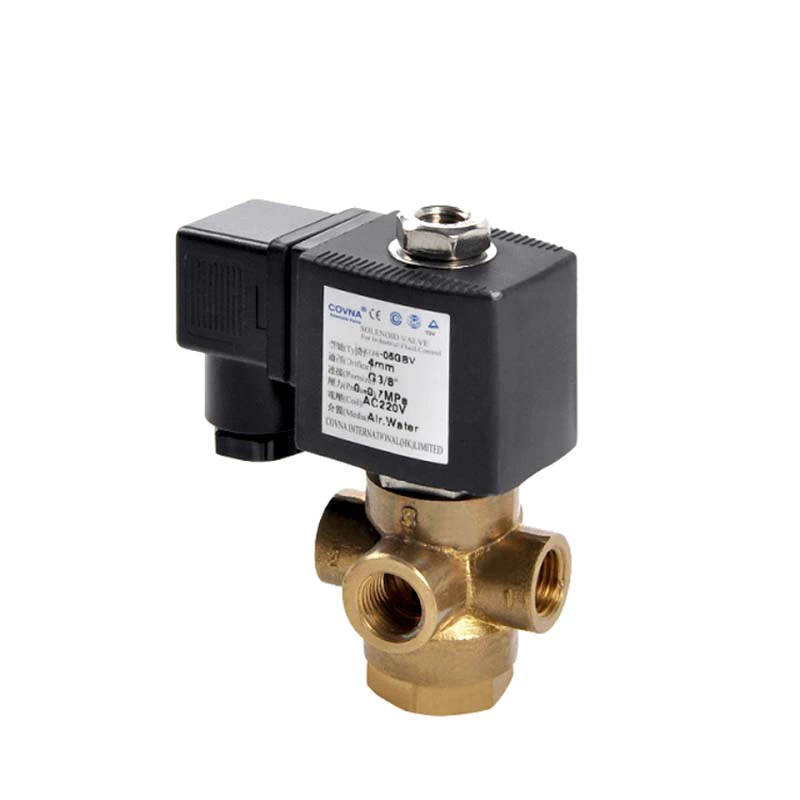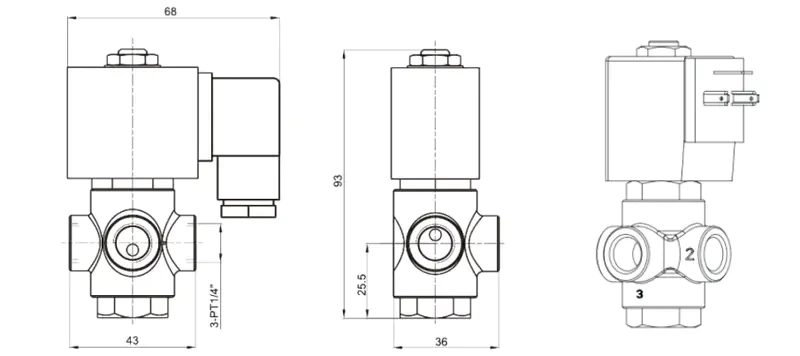COVNA Products


VX31 3 Way Solenoid Valve – Brass
The VX31 3-way solenoid valve is designed to be used in low pressure environments and can open even at pressures as low as zero bar. It fits into any pipe that requires a 3-way valve, allowing you to direct flow where you need it. You can choose between G or NPT thread styles to match your pipe. Power supply options are 12 V DC, 24 V DC, 24 V AC, 110 V AC, or 220 V AC. With twenty years of experience in the field, COVNA knows solenoid valves inside and out. We offer both 2-way and 3-way models, so you can choose the one that best suits your project. Contact us today and our team will recommend the perfect valve for you!
- Function: Normally Closed
- Pressure:0 to 16 bar
- Voltage: DC-12V, 24V; AC-24V, 120V, 240V/60Hz; 110V, 220V/50Hz
- Temperature of Media: -10 to 80℃ (14℉ to 176℉)
- Suitable Media: Water, Air, Oil, Gas, etc
- Material: Brass
Technical Parameters Of COVNA VX-31 Solenoid Valves:
| Port size | 1/8", 1/4" | Orifice(mm) | 1.6, 2.0, 2.5, 3.0, 3.5, 4.0 |
| Port Thread | G, NPT | Function | Normally Closed |
| Pressure | 0 to 16 bar | Voltage | DC-12V, 24V; AC-24V, 120V, 240V/60Hz; 110V, 220V/50Hz |
| Temperature of Media | -10 to 80℃(14℉ to 176℉) | Suitable Media | Water, Air, Oil, Gas, etc |
| Material | Brass | Tolerance | ±10% |
Dimension of COVNA VX-31 Solenoid Valves:
The actuator on my automated valve operates, but the valve won’t turn. Why?
Most likely the valve stem or actuator coupling is broken.
Why doesn’t my valve open or close completely when the actuator operates it?
The electric actuator limit switches or the pneumatic actuator position stops are not correctly adjusted.
When I energize the solenoid on my pneumatic actuated valve, the valve won’t turn. How come?
Probably because there is no air pressure to the solenoid or dirt has jammed it. Also, debris might be trapped inside the valve. Or, the air pressure is not sufficient to operate the actuator. Remember: measure air pressure at the actuator, not at the compressor.
Can I buy an actuator from one manufacturer and mount it to a valve from another manufacturer?
Maybe. First, be sure that the actuator torque output is sufficient to turn the valve reliably. Second, you will have to fabricate a custom mounting bracket and coupling to connect the actuator to the valve.
What happens if I lose power to my electric actuator in the middle of an actuation cycle?
The valve will stop somewhere between full open and close. When power is reapplied to the original circuit, the actuator will complete the cycle.
I ordered a fail open pneumatic actuated valve by mistake. I needed a fail closed one. What can I do?
To make the change just remove the actuator from the valve and turn it, or the valve stem, 90 degrees and remount the actuator.
I’ve installed my automated valve in the line, but now I don’t know if the valve is in the open or closed position. How can I find out?
Remove the actuator from the valve and check the valve stem. Most ball valves have stem flats at right angles to the flow when the valve is in the off position. On butterfly valves check the stem flow arrow marking.
Do I have to have the solenoid valve that controls the air supply to my pneumatic actuator mounted right on the actuator?
Remove the actuator from the valve and check the valve stem. Most ball valves have stem flats at right angles to the flow when the valve is in the off position. On butterfly valves check the stem flow arrow marking.
How do I wire up my electric actuator?
Check the electric wiring schematic that came with the actuator for the correct hookup. Sometimes a copy is inside the actuator cover. If it is missing, don’t guess about the connections. Call the manufacturer for a schematic.
I’ve just installed an electric actuated valve and when I power it, it turns the valve 360 degrees and won’t shut off. What’s wrong?
The actuator is wired incorrectly (check the schematic accompanying the actuator), or the external control switch is not the correct type for the actuator.
My electric actuators cycle time is way too fast, can I slow it down?
Not unless you bought it with an optional speed control.
I just replaced a solenoid valve with an electric actuated valve and it won’t work. Why?
Actuators and solenoid valves require different types of electrical control switches. SPDT for actuators, SPST for solenoids. Check the actuator wiring schematic for the correct wiring and switch type.














